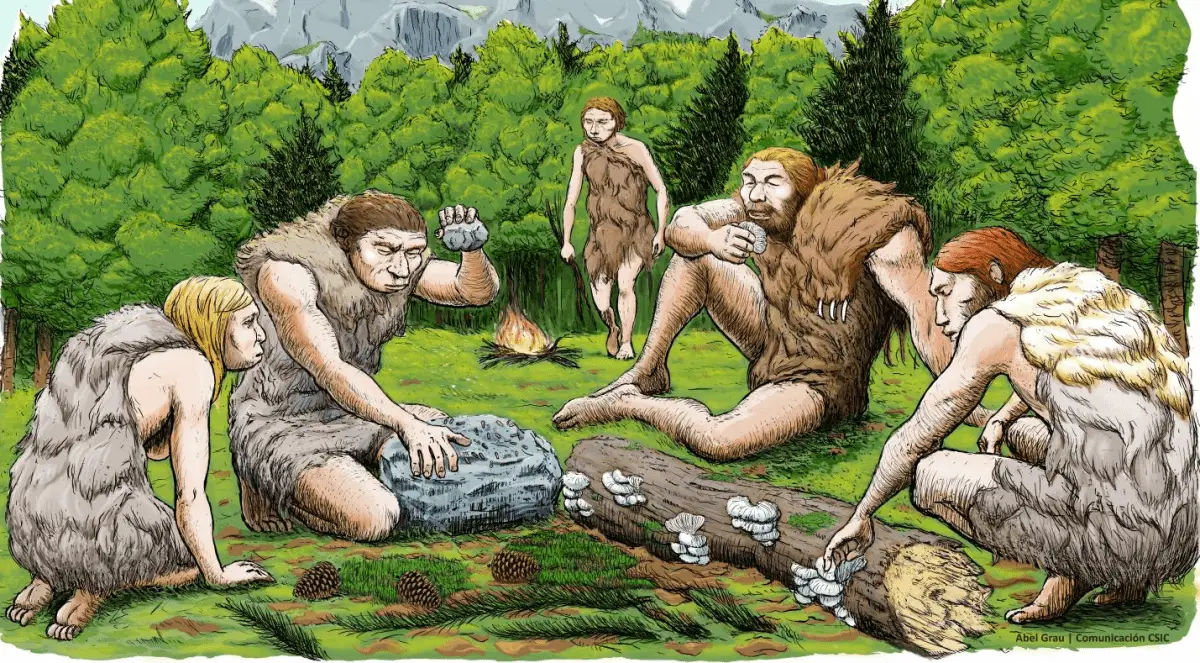Nature magazine, and in which scientific investigators from the Spanish National Research Council (CSIC) collaborated, provides information about the diet of the Neanderthals who inhabited the El Sidrón site in Asturias, northern Spain.
Analysis of genetic material preserved in the calcified dental plaque from these Neanderthals shows that their diet included wild mushrooms, pine nuts and moss, yet no evidence has been found to show they ate meat. This contrasts with the information obtained from the individual, Spy II, in Belgium in whose dental plaque there is DNA from rhinoceros and mouflon and, to further support the theory, other large herbivore fossils were found alongside their remains.
“We were surprised not to find any remains of meat in the Asturias Neanderthals, given that they were thought to be predominantly meat eaters. However, we have found evidence they enjoyed a varied diet including a wide range of plants. What’s more, some of these plants may well have been cooked before being eaten” points out CSIC investigator, Antonio Rosas, who works in Spain’s National Natural Science Museum.
The genomic analyses of dental plaque showed these Asturian Neanderthals ate wild mushrooms (Schizophyllum commune), pine nuts (Pinus koraiensis), moss (Physcomitrella patens), and western balsam-poplar (Populus trichocarpa).
Neanderthals were familiar with medicinal plants
While all we know about one of these individuals is that she was a left-handed adult female, one other individual is considered the ‘Star of the Show’ by the project investigators. As previous studies have pointed out, this male individual appears to have used his mouth to sharpen the blades of stone tools (rather like a third hand), leading to chipping on the enamel and dentine on his upper teeth. Now, the study of his dental plaque has brought new and quite unique information to light.
“We have evidence that this Neanderthal self-medicated. We have discovered that the plaque preserved in his teeth contains sequences of the pathogen Enterocytozoon bieneusi which causes gastrointestinal problems, including serious diarrhoea. Additionally, thanks to a hole in his jaw we know he had a dental abscess. Both health issues must have caused him intense pain”, Rosas points out.
What is more, this Neanderthal’s dental plaque contains traces of DNA from both the natural antibiotic fungus, penicillium, as well as from poplar, a tree whose bark, roots and leaves contain silicic acid, the active ingredient in well-known medications.
This is not the first nod in this direction, given that the researchers at El Sidrón had already taken part in a study which clearly showed that Neanderthals recognised the curative and nutritional properties of some plants, since they took camomile and yarrow, most probably to help digest heavy meals.
Exchange of microorganisms between Neanderthals and sapiens
The scientific investigators compared Neanderthal oral micro-biotic data with human samples from Palaeolithic hunter-gatherers, African nomads, the first Neolithic farmers as well as from present-day man.
“Micro-biotic information is key to learning about the host’s health. Neanderthals for example have fewer potentially pathogenic bacteria than we do. In today’s human population a link has been seen between oral micro-biotics and a spectrum of health issues such as cardiovascular problems, obesity, psoriasis, asthma, colitis and gastroesophageal reflux”, highlights CSIC researcher Carles Lalueza-Fox, who works at the Institute of Evolutionary Biology (a CSIC-University of Pompeu Fabra shared centre).
Furthermore, the dental plaque from the individuals at El Sidrón has also made it possible to retrieve the oldest complete microorganism genome: the ancient Methanobrevibacter oralis, which is now classified as a Neanderthal subspecies. The Neanderthal and modern human strains appear to have diverged between 112,000 and 143,000 years ago, after the two evolutionary lines split.
“Today we know that crossbreeding took place on two occasions between sapiens and those Neanderthals who later lived in the Siberian region, but not with those in Asturias. If there was micro-biotic transfer between the Asturias Neanderthals and sapiens, then perhaps a cross-line existed between them, although we are yet to identify that”, concludes Lalueza Fox.
The El Sidrón cave
The El Sidrón cave, situated in Piloña, in Asturias in northern Spain, has provided the finest Neanderthal collection in the Iberian Peninsula and is one of the most active archaeological dig sites in the world. Discovered in 1994, around 2,500 skeletal remains from at least 13 individuals of both sexes and of varying ages who lived there around 49,000 years ago have been recovered.
The multidisciplinary team which worked at El Sidrón consisted of palaeontologist Antonio Rosas from CSIC’s National Natural Science Museum, the geneticist, Carles Lalueza-Fox, from the CSIC / Institute of Evolutionary Biology’s Pompeu Fabra University mixed centre, and the archaeologist, Marco de la Rasilla, from the University of Oviedo in Asturias.
At El Sidrón, the team developed a pioneering protocol, known as ‘clean excavation’, which minimises the risk of contaminating the early DNA with that of modern-day human DNA from the researchers working on the cave excavation. This allowed both nuclear and mitochondrial DNA to be extracted from teeth and skeletal remains.
SPANISH NATIONAL RESEARCH COUNCIL (CSIC)







